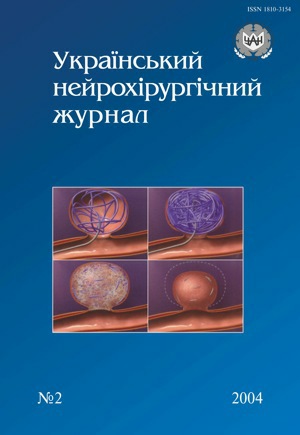Diagnosis of vascular compression of the cranial nerves by use of magnetic resonans imaging, its correlation with the surgical data
Keywords:
cranial nerves, vascular compression, diagnostics, magnetic resonance tomographyAbstract
30 patients with neurovascular compression syndromes: trigeminal and glossopharingeal neuralgia, hemifacial spasm, essential arterial hypertension, were investigated by MRI with CISS-3D consequence, using a 1,5 Tesla Magnetom Vision imaging unit (Siemens, Erlangen, Germany). Correlation of MRI and surgical data have been analysed. High effectiveness of MRI with CISS-3D consequences have been established for diagnosis of cranial nerves vascular compression syndromes.
References
Григорян Ю.А., Оглезнев К.Я., Рощина Н.А. Этиологические факторы синдрома тригеминальной невралгии// Журн. невропатологии и психиатрии им. С.С. Корсакова. — 1994. — №6. — С.18–22.
Штанге Л.А., Оглезнев К.Я., Григорян Ю.А., Рощина Н.А. Результаты микроваскулярной декомпрессии добавочного нерва у больных со спастической кривошеей // Вопр. нейрохирургии. — 1998. — №3. — С.17–19.
Apfelbaum R.I. Long-term results of surgical treatment for trigeminal neuralgia // Neurosurgery. — 1996. — V.39, N3. — P.649–70.
Bejjani G.K., Sekhar L.N. Repositioning of the vertebral artery as treatment for neurovascular compression syndromes. Technical note // J. Neurosurg. — 1997. — V.86. — P.728–732.
Devor M., Govrin-Lippmann R., Rappaport H. et al. Cranial root injury in glossopharyngeal neuralgia: electron microscopic observations. Case report // J. Neurosurg. — 2002. — V.96. —P.603–606.
Fukuda H., Ishikawa M., Okumura R. Demonstration of neurovascular compression in trigeminal neuralgia and hemifacial spasm with magnetic resonance imaging. Comparison with surgical findings in 60 consecutive cases // Surg. Neurol. — 2003. — V.59. — P.93–100.
Gardner W.J. Cross-talk — the paradoxical transmission of a nerve impulse // Arch. Neurol. — 1966. — N4. —P.149–156.
Holley P., Bonafe A., Brunet E. et al. The contribution of “time-of-flight” MRI-angiography in the study of neurovascular interactions (hemifacial spasm and trigeminal neuralgia) // J. Neuroradiol. — 1996. — V.23, N3. — P.149–156.
Jannetta P.J. Arterial compression of the trigeminal nerve at the pons in patients with trigeminal neuralgia // J. Neurosurg. — 1967. — N26. — P.159–162.
Jannetta P.J. Neurovascular compression in cranial nerve and systemic disease // Ann. Surg. — 1980. — N192. — P.518–525.
Jansen J., Bardosi A., Hildebrandt J., Lucke A. Cervicogenic, hemicranial attacks associated with vascular irritation or compression of the cervical nerve root C2: Clinical manifestations and morphological findings // Pain. — 1989. — N39. — P.203–212.
Kakizawa Y., Hongo K., Takasawa H. et al. “Real” three-dimensional constructive interference in steady-state imaging to discern microneurosurgical anatomy // J. Neurosurg. — 2003. — N98. — P.625–630.
Kumon Y., Sakaki S., Kohno K. et al. Three-dimensional imaging for presentation of the causative vessels in patients with hemifacial spasm and trigeminal neuralgia // Surg. Neurol. — 1997. — V.47. — P.178–84.
Kumon Y., Sakaki S., Ohue S. et al. Usefulness of heavily T2-weighted magnetic resonance imaging in patients with cerebellopontine angle tumors // Neurosurgery. — 1998. — V.43, N6. — P.1338–1343.
Levy E.I., Clyde B., McLaughlin M., Jannetta P.J. Microvascular decompression of the left lateral medulla oblongata for severe refractory neurogenic hypertention // Neurosurgery. — 1998. — V.43, N1. — P.1–8.
Levy E.I., Scarrow A.M., Jannetta P.J. Microvascular decompression on the treatment of hypertention: review and update // Surg. Neurol. — 2001. — V.55. — P.2–11.
Lovely T.J. Efficacy and complications of microvascular decompression: a review // Neurosurg. Q. — 1988. — N8. — P.92–106.
Meaney J.F .M., Eldridge P.R., Dunn L. T. et al. Demonstration of neurovascular compression in trigeminal neuralgia with magnetic resonance imaging // J. Neurosurg. — 1995. — N83. — P.799–805.
Mitsuoka H., Arai H., Tsunoda A. et al. Microanatomy of cerebellopontine angle and internal auditory canal: study with new magnetic resonance imaging technique using three-dimensional fast spin echo // Neurosurgery. — 1999. — V.44, N3. — P.561–566.
Moller A.R. The cranial nerve vascular compression syndrome:II.A review of pathophysiology // Acta Neurochir. (Wien). — 1991. — N113. — P.24–30.
Saglitz S.A., Gaab M.R. Investigations using magnetic resonance imaging: is neurovascular compression present in patients with essential hypertension? // J. Neurosurg. — 2002. — N96. — P.1006–1012.
Shimizu T., Kawasaki H., Kasuya H., Kurita K. Diagnosis of vascular compression in facial spasm by stereoscopic short-range magnetic resonance angiography // J. Neurosurg. — 1995. — N83. — P.561–562.
Wilkins R.H. Hemifacial spasm: a review // Surg. Neurol. — 1991. — V.36. — P.251–277.
Wilkins R.H. Neurovascular decompression procedures in the surgical management of disorders of cranial nerves V, VII, IX, and X to treat pain. — Baltimor: Williams&Wilkins, 1996. — 1467 p.
Yousry I., Moriggi B., Schmid U.D. et al. Detailed anatomy of the intracranial segment of the hypoglossal nerve: neurovascular relationships and landmarks on magnetic resonance imaging sequences // J. Neurosurg. — 2002. — V.96. — P.1113–1122.
Downloads
How to Cite
Issue
Section
License
Copyright (c) 2004 V. O. Fedirko, O. Y. Chuvashova

This work is licensed under a Creative Commons Attribution 4.0 International License.
Ukrainian Neurosurgical Journal abides by the CREATIVE COMMONS copyright rights and permissions for open access journals.
Authors, who are published in this Journal, agree to the following conditions:
1. The authors reserve the right to authorship of the work and pass the first publication right of this work to the Journal under the terms of Creative Commons Attribution License, which allows others to freely distribute the published research with the obligatory reference to the authors of the original work and the first publication of the work in this Journal.
2. The authors have the right to conclude separate supplement agreements that relate to non-exclusive work distribution in the form of which it has been published by the Journal (for example, to upload the work to the online storage of the Journal or publish it as part of a monograph), provided that the reference to the first publication of the work in this Journal is included.









